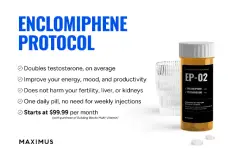androgen insensitivity syndrome is rare.
Regarding the thrown around term androgen resistance used on the numerous forums littered on the internet especially the ones where everyone and their brother that was struggling on a trt protocol claimed that they need to be running absurdly high trough TT/FT levels to feel good.
If you want to put any weight behind the sensitivity of the AR (androgen receptor) and polymorphism of the AR/CAG repeat length (short/long).....sure.
Even then if such were the case highly doubtful one would need the so-called extremely high doses of T 300-600 mg/week you may think to overcome this and experience the beneficial effects of testosterone!
Again the majority of men on trt would be able to achieve a healthy FT level using <200 mg/week and some much less.
Sure some men may need slightly higher doses than 200 mg/week but it is far and few!
There are definitely some rare cases where I have heard of people claiming to need doses in the 250-300 mg/week range to overcome this so-called resistance let alone the ones who claim they would need such dose just to hit a high enough TT/FT level to reap the beneficial effects.
-------------------------------------------------------------------------------------------------
Androgen Sensitivity: Beyond the Well-Known © Irina A. Khripun*, Sergey V. Vorobyev Rostov State Medical University, Rostov-on-Don, Russia The gonadal and extragonadal effects of testosterone in men have been actively studied in recent years. To date there is no doubt an increased risk of...

www.excelmale.com
Androgen Sensitivity: Beyond the Well-Known (2020)
*The study of sensitivity to androgens, determined by the length of the trinucleotide repeat CAG in the gene AR, not only explains the phenomenon of a different response to STT in patients with the same level of endogenous T but also is necessary for understanding sexual differentiation, psychological status, sexuality, and reproductive potential, as well as the risks of developing pancreatic cancer and BPH, osteoporosis, disorders of carbohydrate, lipid metabolism and even cardiovascular disease in men. The most important in clinical practice is the ability to predict the patient's response to the STT. In individuals with a low number of CAG repeats in the gene AR due to its high sensitivity to androgens lower doses of T drugs may be used, whereas starting dose inefficiency TRT in men with a large number of trinucleotide repetitions, indicates the need to increase the dose of T.
*Determination of the CAG polymorphism of the AR gene is not recommended for routine practice, but in the near future, it can be used in particular for the selection of individual therapy for androgen deficiency.
It should be finally acknowledged that the AR CAG repeat polymorphism plays a role in testosterone replacement therapy of males with hypogonadotropic gonadism since shorter AR gene CAG tract lengths was found to yield greater metabolic improvement in response to testosterone administration...

www.excelmale.com
Influence of CAG Repeat Polymorphism on the Targets of Testosterone Action (2015)
*
at present AR CAG polymorphism is not recommended in the routine setting however in the near future it could become of clinical relevance because of the theoretical possibility of identifying subjects more or less at risk for various disorders more or less responsive to testosterone treatment
* study of CAG repeat length could allow us to individually tailor testosterone replacement therapy as subjects with shorter CAG repeat could need lower doses of testosterone while men with longer repeats could require higher ones
The CAG repeat polymorphism within the androgen receptor gene and maleness (2003)
Conclusion
The highly polymorphic nature of glutamine residues within the AR protein causes a subtle gradation of androgenicity among individuals. This modulation of androgen effects may be small but continuously present during a man’s lifetime, thus exerting effects that are measurable in many tissues as various degrees of androgenicity (Fig. 2). It remains to be elucidated whether these insights are important enough to become part of individually useful laboratory assessments. Nevertheless, in interaction with androgens, the CAG repeat polymorphism within the AR gene represents a relevant effector of maleness.
-------------------------------------------------------------------------------------------------
I consulted a psychiatrist who has been using high doses of t3 for years for patients who have unipolar depression and bipolar depression. Some patients need 100, up to 200 mcg, daily. Dr. Peter Whybrow, chief of psychiatry at UCLA has been researching and using high dose t4 in treatment resistant bipolar patients for decades.
Regarding testosterone we very well know it has positive effects on mood such as anxiety and depression (mild to moderate) but the jury is still out when it comes to MDD (major depressive disorder).
Symptom resolution, irrespective of dose, is valid.
True up to a point.....side-effects/blood markers!
The only study of supraphysiologic testosterone was dosed up to 600 mg, weekly, and though it was a small study, no ill effects were manifested.
What the one with 43 men.....oh I mean 40 men.....damn I meant the 21 men on testosterone!
Yes at 600 mg T/week for 10 weeks and unfortunately testosterone levels will be in flux during the weeks leading up until blood levels have stabilized (4-6 weeks) so how many weeks are the 21 men at steady-state!
Definitely not a full 10.
Regardless if you are concerned with using testosterone for the sole purpose of muscle enhancement then banging steroid doses 300-600 mg/week of T would make sense.
Anyone claiming to need such absurdly high doses to achieve a so-called healthy FT let alone overcome the thrown around term androgen resistance that is commonly spouted on the numerous forums littered on the internet is just Ludacris!
-------------------------------------------------------------------------------------------------
The Effects of Supraphysiologic Doses of Testosterone on Muscle Size and Strength in Normal Men (1996)
Methods
We randomly assigned 43 normal men to one of four groups: placebo with no exercise, testosterone with no exercise, placebo plus exercise, and testosterone plus exercise. The men received injections of 600 mg of testosterone enanthate or placebo weekly for 10 weeks. The men in the exercise groups performed standardized weight-lifting exercises three times weekly. Before and after the treatment period, the fat-free mass was determined by underwater weighing, muscle size was measured by magnetic resonance imaging, and the strength of the arms and legs was assessed by bench-pressing and squatting exercises, respectively.
Methods
STUDY DESIGN
This study was approved by the institutional review boards of the Harbor–UCLA Research and Education Institute and the Charles R. Drew University of Medicine and Science. All the study subjects gave informed written consent. The subjects were normal men weighing 90 to 115 percent of their ideal body weights; they were 19 to 40 years of age and had experience with weight lifting. They were recruited through advertisements in local newspapers and community colleges. None had participated in competitive sports in the preceding 12 months. Men who had ever taken anabolic agents or recreational drugs or had had a psychiatric or behavioral disorder were excluded from the study.
Of 50 men who were recruited, 7 dropped out during the control period because of problems with scheduling or compliance. The remaining 43 men were randomly assigned to one of four groups: placebo with no exercise, testosterone with no exercise, placebo plus exercise, and testosterone plus exercise. The study was divided into a 4-week control period, a 10-week treatment period, and a 16-week recovery period. During the four-week control period, the men were asked not to lift any weights or engage in strenuous aerobic exercise.
Of the 43 men, 3 dropped out during the treatment phase: 1 because of problems with compliance, 1 because illicit-drug use was detected by routine drug screening, and 1 because of an automobile accident.
Forty men completed the study: 10 in the placebo, no-exercise group; 10 in the testosterone, no-exercise group; 9 in the placebo-plus-exercise group; and 11 in the testosterone-plus-exercise group.
Treatment
The men received either 600 mg of testosterone enanthate in sesame oil or placebo intramuscularly each week for 10 weeks in the Clinical Research Center. This dose is six times higher than the dose usually given as replacement therapy in men with hypogonadism and is therefore supraphysiologic. Doses as high as 300 mg per week have been given to normal men for 16 to 24 weeks without major toxic effects.34
Notice that the dose used in the study is 6X higher than the average dose given (100 mg/week) to men on trt.
At least you have some
short-term studies using doses in the 300 mg/week range for 16-24 weeks without
major toxic effects......keyword being
major!
You and I both very well know that if a majority of men were put on 300 mg T/week (lower-end supraphysiological) for trt that they would be struggling with sides let alone TT/FT levels would be through the roof.
TRT is long-term.
The take-home point!
Our results in no way justify the use of anabolic-androgenic steroids in sports, because, with extended use, such drugs have potentially serious adverse effects on the cardiovascular system, prostate, lipid metabolism, and insulin sensitivity. Moreover, the use of any performance-enhancing agent in sports raises serious ethical issues.
Our findings do, however, raise the possibility that the short-term administration of androgens may have beneficial effects in immobilized patients, during space travel, and in patients with cancer-related cachexia, a disease caused by the human immunodeficiency virus, or other chronic wasting disorders














